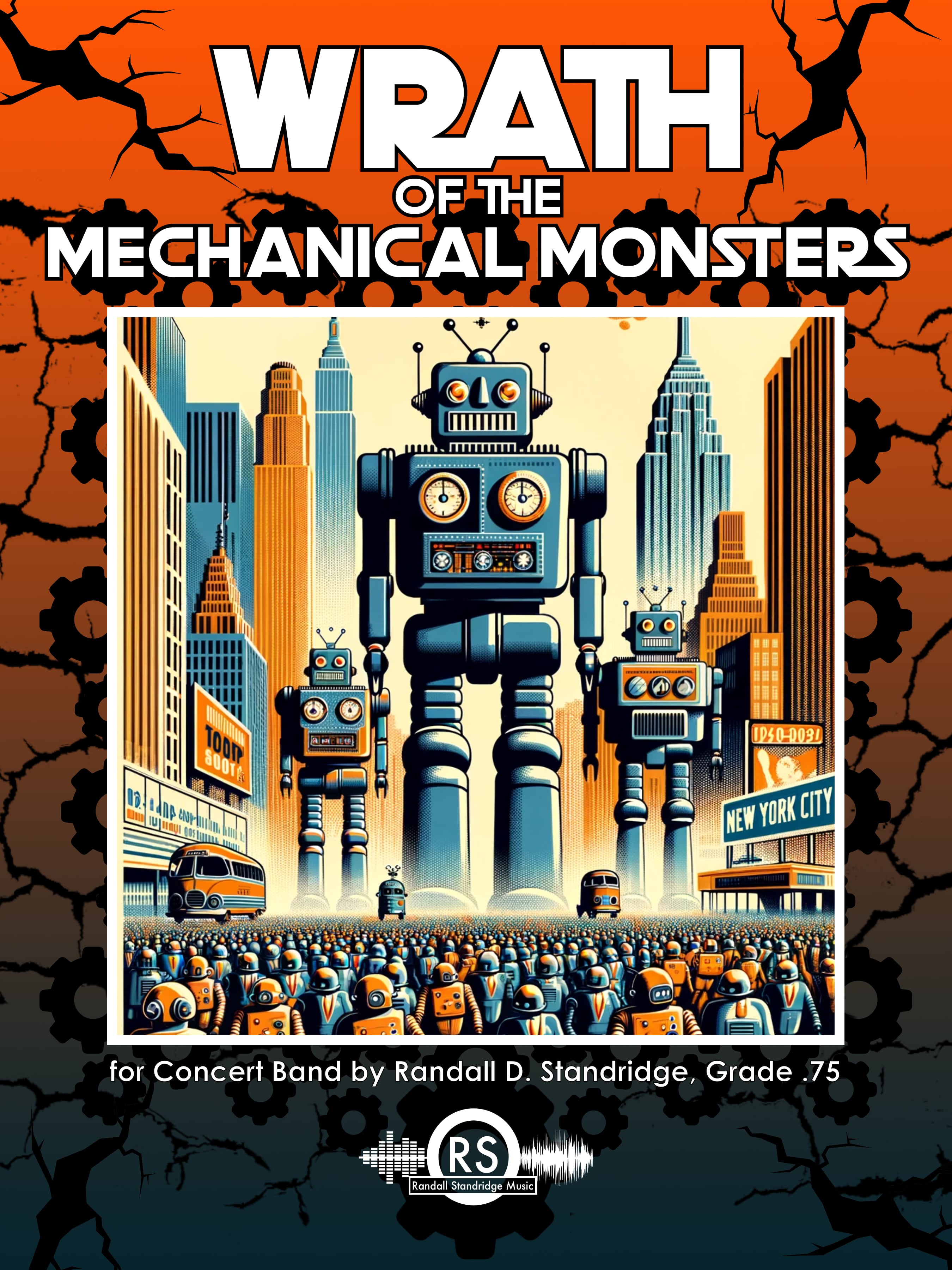Wrath of the Mechanical Monsters
Wrath of the Mechanical Monsters - Randall Standridge
About Wrath of the Mechanical Monsters
A couple of years ago, I wrote a piece entitled Mechanical Monsters. It was my first stab at writing Grade .5 literature, and I was very pleased with the results. The piece seemed to resonate with students and conductors alike, which tickled me to no end. The B-movie idea of robotic monstrosities roaming the landscape is very much to my personal tastes, and I’m glad so many enjoyed it. And just like any B-movie, I thought, “well, why not do a sequel.”
There are a million reasons not to do a sequel.
Unlike something original, a sequel comes laden with expectations, the central question people ask being: “Will this live up to the first one?”
I don’t know. I hope so.
Much like my Santa the Barbarian series, as well as the ongoing Starfire, 16th Empire, and Darklands sagas, I promised myself I wouldn’t write another one unless I had a really good idea. So, I sat on it for a few years. Eventually, titles started occurring to me, all styled after the title of horror sequels from the ’50s and ’60s. Bride of the Mechanical Monsters. Attack of the Mechanical Monsters. Son of the Mechancail Monsters. Day of the Mechanical Monsters. Mechanical Monsters Beach Party A-Go-Go.
No, no, no, no, and (as fun as it sounds) no.
Then, on a napkin in a restaurant, I wrote the following: Wrath of the Mechanical Monsters.
Bingo.
This satisfied the B-Movie title I was looking for, while also suggesting that I incorporate the chant tune Dies Irae (Day of Wrath) into the work. I also knew I needed to make it a little bit more challenging rhythmically and harmonically, as it needed to be a logical continuation of the educational concepts of the first one.
So, here we are again, my friends. In the work, you will hear sirens and the sound of marching mechanical monstrosities as they make their way into the city to wreak havoc on the general populace and bring their own brand of musical destruction to the cityscape. Beware, my friends, for the day of reckoning is upon us! Run for your lives! They’re here! They’re here!
Peace, Love, and Music (and imminent destruction…again! Mwahahahahaaa!)
Educational goals of the work:
-8th Note counting and independence, dotted Quarter Note Patterns
-First and Second Ending Repeats, as well as D.S. al Coda (Dies Irae al Coda?)
-Articulations: Staccato, Tenuto, Accents
-This work uses the range of the first 6 notes that are typically taught to developing band students but adds in the concert Db and Concert F#. I have tried to make it repetitive enough that teaching and retention would be easy and effective.
There are additional educational materials, including an optional “B” snare part which is a little bit easier on the product page for the piece. Please visit our website! randallstandridge.com
Rehearsal suggestions
-The tempo of this work is critical to its character. When planning your preparation, make sure to allow time for proper technical development to achieve the written tempos, lest the work come off as “boring.”
-There are two optional “skips” in the piece to make it shorter and less demanding (m.44, m.52).
-If a Marching Machine is not available, consider using chains to lightly tap on a wooden surface or have the entire ensemble stomp.
-The clarinets may be assigned the regular part OR the optional French Horn double (or you may split your section as needed).
-The “Two Metal Objects” for Percussion 3 may be interpreted very broadly. Cowbells, Agogo Bells, Anvils, Brake Drums, Pots, Pans...It’s up to you! However, their relative pitch should be as written (High/Low)
-The Mallet part may be doubled on a synthesizer. The more distorted and obviously “digital” the sound, the better. It needs to be a sound that the concert band could not produce.
-When the wind players are asked to hiss, it needs to be audible, loud, and energetic.
-For the pencil on Stand section, the “top” of the stand is the face plate where the music rests, and the “body” is the stem or shaft of the stand. I absolutely refused to put the word “shaft” anywhere that a Jr. High kid could read it and giggle. Once again, You’re welcome.
